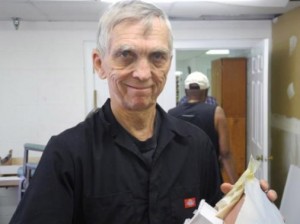October 15, 2019 —MITCHELLVILLE, Md., Aug. 29, 2011 –A feature story in the new edition of Guide to Retirement Living SourceBook reveals how residents of one retirement community have used Amateur Radio, often called “ham radio,” to maintain purpose, friendship and even their own health.
When Grant Bagley and his wife decided to make the move to a retirement community, he believed he would have to give up ham radio, a lifelong hobby of his. The retired physician and attorney said he thought at the time, “I may have to give that up, but I can replace it with other things.” Fortunately, his community, Collington, had plenty of other activities and interesting new friends to keep Grant occupied.

But not long after moving to the Continuing Care Retirement Community in suburban Washington, D.C., Grant connected with several other residents who were also ‘hams.’ Working with these individuals, Grant has helped set up a fully functional Amateur Radio center in the extensive woodshop at Collington. Not only will the radio station provide a venue for the enthusiasts, but as Grant said, “It will serve as an integral part of the emergency communications systems in the county.”
When an emergency strikes, even if internet and phone systems are still working, they are often overloaded as everyone tries to use them at once. The Amateur Radio Emergency Service (ARES®) is a nationwide program of the ARRL – the national association for Amateur Radio. It provides Amateur Radio communications for critical organizations in emergencies. Emergency Management Centers, the American Red Cross, the Salvation Army, FEMA, CERT, National Weather Service, many hospitals and others have formal agreements with the hams. Ham radio volunteers have been lifesavers in the Haitian earthquake, Japanese tsunami, and in many hurricanes and tornadoes in the United States.
Despite this, it was a personal connection with a resident in the community’s nursing and rehabilitation section that really opened the door to a meaningful purpose for the radio. Grant was recently approached by another resident with vision problems who told him, “I’ve lost my sight and the worst thing is I have nobody to talk to. I should have never gotten rid of my ham radio license.”
Without hesitation, Grant had responded “Let’s get you one again and you’ll have all the people you want to talk to.” Grant is working to help him study for the FCC tests needed to earn an Amateur Radio license. When discussing this connection, Grant could not help but beam with enthusiasm, saying, “He’s going to be up here, so it’s growing; it’s great.”
Grant continued, saying, “People think that ham radio is not as viable a hobby, but in this age of the Internet, it’s even more so.” This is right on track with American Radio Relay League, the national association for Amateur Radio in the United States. According to Allen Pitts at the ARRL’s national headquarters, there are over 695,000 ham radio licensees in the United States today – more than ever before. Approximately 30,000 new hams earn their first licenses each year. “Collington is an excellent example of creative thinking in a retirement community. Their inclusion of Amateur Radio opens the doors to hands-on learning about wireless communication, provides social interaction in a most enjoyable hobby and also can quickly become a functional emergency communications option for residents.”
While this may be a unique activity when compared to other retirement communities throughout the country, Collington is known for a robust list of activities all driven by a highly intelligent and diverse group of residents. Whether individuals are building and racing model sailboats or playing on the competitive croquet team, the community supports thinking creatively. “Collington is full of interesting people who really know how to live into life. We’re all extremely active and very social. It’s easy to find new friends”, says long-time resident Marion Henry, who chairs two committees at Collington.
Guide to Retirement Living SourceBook founder and publisher, Steve Gurney, said, “We are thrilled to spotlight this unique and positive way of engaging residents in a retirement community. Stories like these help us break the stigma of life in a senior living community and they offer inspiration to seniors and families that this is the best time in life to engage in purposeful activities.”
The article and excerpts from the video interviews with Grant and other Collington residents can be accessed at www.retirement-living.com. Information about Amateur Radio is at www.Hello-Radio.org and www.ARRL.org.